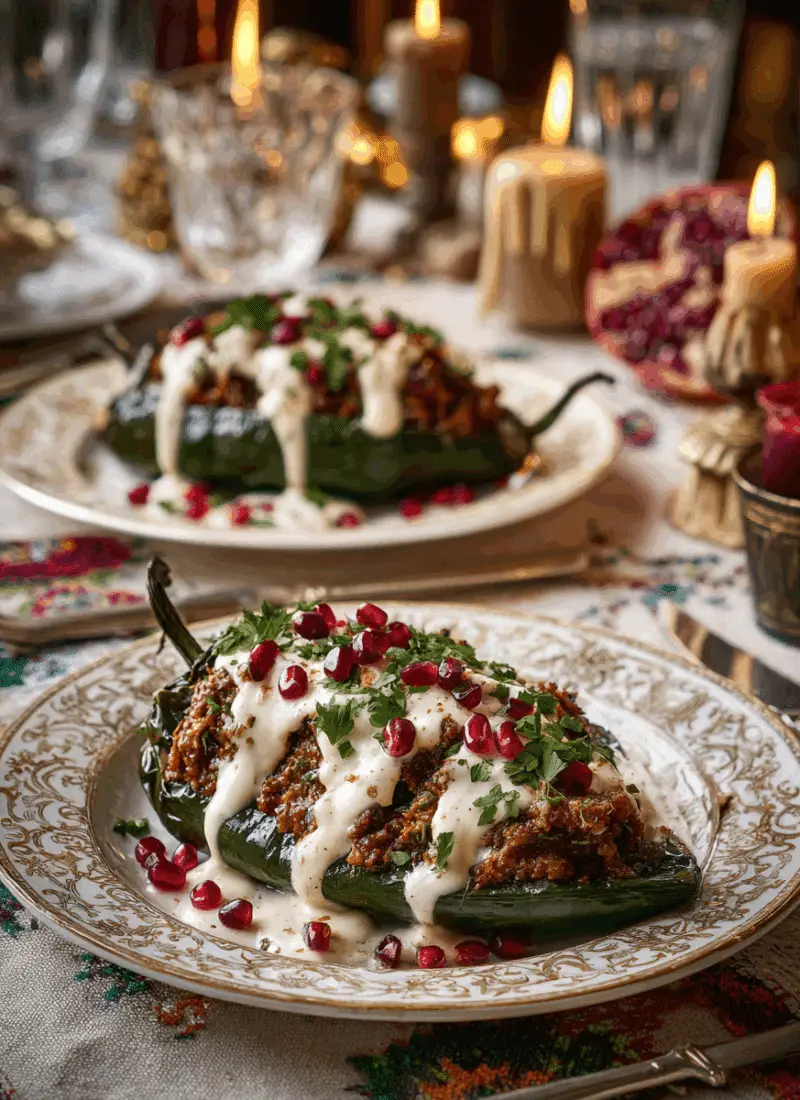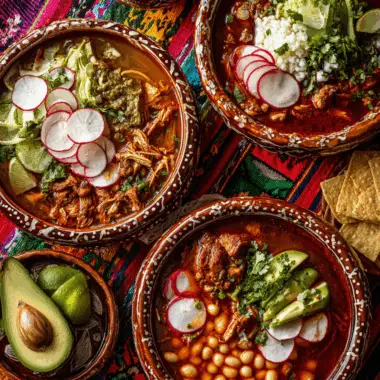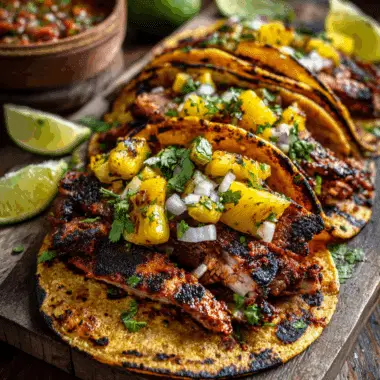Chiles en Nogada is a traditional Mexican dish with deep historical and cultural significance, often served during the celebrations of Mexican Independence Day in September. Originating from Puebla, this iconic dish features poblano chiles stuffed with a picadillo-style meat and fruit filling, topped with a rich walnut cream sauce (nogada), and garnished with pomegranate seeds and parsley representing the colors of the Mexican flag.
FULL RECIPE
Ingredients
1.For the Filling (Picadillo):
- 1 lb ground pork (or a mix of pork and beef)
- 1/2 onion, finely chopped
- 2 garlic cloves, minced
- 2 tablespoons olive oil
- 2 ripe tomatoes, peeled and chopped
- 1/4 cup chopped almonds
- 1/4 cup chopped candied citron (or candied fruit mix)
- 1/4 cup raisins
- 1 small apple, peeled and diced
- 1 small pear, peeled and diced
- 1 small peach, peeled and diced
- 1/2 teaspoon ground cinnamon
- 1/4 teaspoon ground cloves
- Salt and pepper to taste
2.For the Chiles:
- 6 large poblano peppers
- Vegetable oil (for frying, optional)
- 6 eggs, separated (if batter-frying)
- 1/4 cup flour (for dusting, if batter-frying)
3.For the Nogada (Walnut Sauce):
- 1 cup walnuts, blanched and peeled
- 1/2 cup milk (or as needed for consistency)
- 1/4 cup fresh cheese (such as queso fresco or ricotta)
- 1/4 cup Mexican crema (or sour cream)
- 1 tablespoon sugar
- 1/4 teaspoon cinnamon
- Salt to taste
4.For Garnish:
- 1/2 cup pomegranate seeds
- Fresh parsley leaves, chopped
Directions
- Prepare the Chiles:
Roast the poblano peppers over an open flame or under a broiler until charred on all sides. Place in a sealed plastic bag or covered bowl for 10 minutes. Peel off the skin, then carefully slit each chile and remove the seeds, keeping the stem intact. Set aside. - Make the Filling (Picadillo):
Heat olive oil in a skillet over medium heat. Sauté the onions until translucent, then add garlic and cook for 1 minute. Add ground meat and cook until browned. Stir in tomatoes and simmer until soft. Mix in almonds, candied fruit, raisins, diced apple, pear, peach, cinnamon, and cloves. Cook for 10–15 minutes, stirring occasionally, until the mixture thickens. Season with salt and pepper to taste. Let it cool slightly. - Stuff the Chiles:
Carefully spoon the picadillo filling into each poblano chile. If not batter-frying, place them directly on a serving platter. - (Optional) Batter-Fry the Chiles:
Beat egg whites until stiff peaks form, then gently fold in egg yolks. Dust the stuffed chiles with flour, dip in the egg batter, and fry in hot oil until golden. Drain on paper towels. - Make the Nogada (Walnut Sauce):
Blend the blanched walnuts with milk, cheese, crema, sugar, cinnamon, and salt until smooth and creamy. Adjust milk quantity for desired consistency. - Assemble the Dish:
Place each stuffed chile on a plate. Pour the walnut sauce over the top. Garnish with pomegranate seeds and parsley to represent the Mexican flag’s red, white, and green.
Nutrition Facts
- Calories: 520
- Protein: 25g
- Fat: 35g
- Saturated Fat: 10g
- Carbohydrates: 28g
- Fiber: 5g
- Sugars: 12g
- Sodium: 420mg
- Cholesterol: 125mg
Seasonal Importance and Availability
This dish is deeply seasonal and is typically prepared in late summer through early autumn when ingredients like walnuts, pomegranates, and poblano peppers are at their peak freshness in Mexico. These seasonal ingredients not only ensure optimal flavor and texture but also enhance the visual vibrancy of the dish. The timing also coincides with the nation’s Independence Month, making the availability of fresh produce a perfect match for the cultural significance of the recipe.
Nutritional Benefits
Chiles en Nogada offers a diverse range of nutrients due to its blend of fruits, nuts, and lean proteins. The stuffing contains fruits like apples and pears, which are high in dietary fiber and antioxidants. Ground pork or beef provides a solid source of protein and iron, while walnuts are rich in omega-3 fatty acids, promoting heart health. The dish, despite its luxurious appearance, can be quite balanced when portioned appropriately. Additionally, using leaner meat or substituting dairy in the sauce can enhance its nutritional profile for health-conscious individuals.
Flavor Profile and Texture
This dish is celebrated for its sophisticated combination of sweet and savory elements. The picadillo filling merges the umami of ground meat with the sweetness of fresh and dried fruits, spiced with cinnamon and cloves. The poblano pepper adds a mild smokiness, while the creamy walnut sauce lends richness and a slightly sweet finish. The burst of tartness from the pomegranate seeds provides a bright contrast and refreshing crunch, while the parsley introduces a hint of herbaceous freshness. Together, these components create a harmonious and layered sensory experience.
Regional and Family Variations
Although the traditional version hails from Puebla, regional and family-specific variations exist throughout Mexico. Some families use different meats like ground beef or even shredded chicken. Others prefer adding plantains or pine nuts to the filling. In some cases, the dish is served cold, while in others, it is served warm. The nogada sauce also sees tweaks—some families include a touch of sherry, brandy, or goat cheese for added complexity. These variations allow for personalization while preserving the soul of the original recipe.
Serving and Presentation Tips
Presentation is key to honoring the historical and cultural elegance of Chiles en Nogada. It is typically served individually plated, with the chile fully covered in walnut sauce and artfully topped with a generous sprinkle of ruby-red pomegranate seeds and finely chopped parsley. White ceramic plates often highlight the colors best. For a more refined touch, lightly toast the walnuts before blending for deeper flavor, and chill the sauce slightly before serving to maintain its consistency and sheen.
Pairing Suggestions
This rich and complex dish pairs best with light and refreshing drinks that balance its flavors. White wines with crisp acidity like Sauvignon Blanc or a slightly sweet Riesling complement the creamy nogada and sweet filling. For non-alcoholic options, a cold glass of agua de jamaica (hibiscus tea) or a lightly carbonated citrus drink enhances the meal. As for side dishes, a simple green salad or steamed white rice can accompany the chiles without overwhelming the palate.
Make-Ahead and Storage Tips
While Chiles en Nogada is best enjoyed freshly assembled, many components can be prepared ahead of time. The picadillo can be cooked and stored in the refrigerator for up to three days. The nogada sauce can also be made a day ahead, though it’s best to blend just before serving to maintain freshness. Stuffed peppers can be kept in the refrigerator, separated from the sauce, and assembled when ready to serve. Avoid freezing the dish, as the creamy sauce and fresh fruits may not hold up well after thawing.
Vegetarian and Dietary Alternatives
For those following a vegetarian diet, the ground meat in the picadillo can be substituted with textured vegetable protein (TVP), lentils, or finely chopped mushrooms. To make the dish dairy-free, swap out traditional crema and cheese in the nogada sauce for plant-based alternatives such as soaked cashews blended with almond milk and lemon juice. Reducing the sugar content in the sauce and avoiding batter-frying the peppers can make the dish more suitable for those managing blood sugar or cholesterol levels.
Historical Legends and Culinary Pride
There’s a romantic legend attached to the origins of Chiles en Nogada, claiming that it was invented by Augustinian nuns in Puebla to impress General Agustín de Iturbide in 1821. Whether fact or folklore, the story enhances the dish’s prestige and charm. Over time, Chiles en Nogada has become a symbol of Mexico’s mestizo heritage—a blend of Indigenous and European influences—and is often highlighted as a masterpiece in the pantheon of Mexican gastronomy.
Conclusion
Chiles en Nogada is much more than a festive dish; it is a celebration of history, culture, and the rich agricultural bounty of Mexico. From its patriotic colors to its intricate blend of flavors, every element reflects thoughtfulness and tradition. Whether you’re making it for the first time or continuing a family legacy, the process of preparing Chiles en Nogada is as rewarding as it is delicious.








